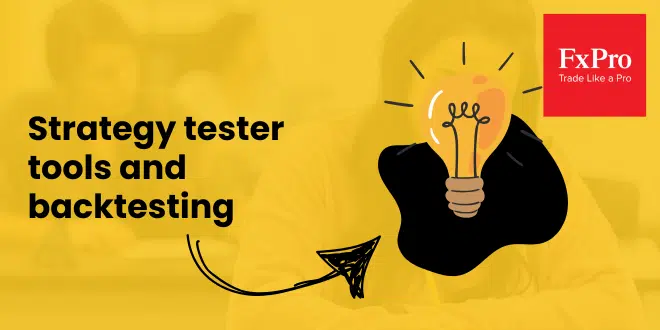Imagine building a trading strategy you feel good about—only to watch it fail the moment real money is on the line. That hurts. But here’s the good news: it’s avoidable. Thanks to strategy tester tools and backtesting features on FxPro, you can test your idea in a safe, risk-free way before risking a single cent.
Whether you’re a new trader exploring simple setups or someone a bit more advanced designing custom algorithms, backtesting can turn guesswork into growth. This guide will walk you through exactly how it works on FxPro platforms, what tools are available, how to run your first backtest, and the common mistakes to watch out for.
What is backtesting—and why does it matter?
Backtesting means using historical price data to simulate how your trading strategy would have performed in the past. Think of it like a time machine. You’re not predicting the future—you’re measuring how a specific set of rules would have worked if you had used them before.
Why it matters:
- It shows if your idea has real-world potential
- It helps you spot weaknesses before risking money
- It builds confidence in a strategy
- It teaches patience by showing long-term results
- It gives you a safe space to practice, refine, and learn
You wouldn’t drive a car without testing the brakes. Why trade without testing your strategy?
Manual backtesting vs automated backtesting – What’s the difference?
There are two types of backtesting you’ll come across.
Manual backtesting means scrolling through charts and marking down trades one by one. It’s great for learning price action and testing simple rules.
Automated backtesting uses tools like MetaTrader’s strategy tester to simulate hundreds of trades at once. It’s faster and more accurate, especially for rule-based systems.
Start with manual testing to build market intuition. Then use automation to scale your ideas with speed.
Does FxPro offer strategy testing tools?
Yes—but it depends on which platform you’re using. FxPro supports four trading platforms, and backtesting features vary:
- MetaTrader 4 (MT4): Includes a built-in Strategy Tester
- MetaTrader 5 (MT5): Also has a more advanced Strategy Tester
- cTrader: Doesn’t have a native tester but supports cAlgo coding + third-party testing tools
- FxPro Direct (web/app): Doesn’t support backtesting; designed for execution and management only
If you’re serious about backtesting, you’ll want to use MT4 or MT5 through FxPro.
MT4 Strategy Tester: A beginner-friendly starting point
MT4 lets you test automated strategies called Expert Advisors (EAs). Even if you’re not into coding, you can use free EAs or strategy builders to test ideas.
Steps to run a basic backtest:
- Open MT4 and go to View > Strategy Tester
- Select your EA and asset (like EUR/USD)
- Choose your timeframe and dates
- Enter test settings (like deposit size)
- Hit “Start” and view results
Pro Tip: Use “Visual Mode” to watch trades happen in real time on the chart.
MT5 Strategy Tester: More power, more detail
MT5 takes backtesting further with:
- Real tick data support
- Faster multi-threaded testing
- Optimization options
- Forward testing features
- Performance graphs and stats
It’s ideal for traders who want deeper insight or who plan to optimize large sets of strategy rules.
What about cTrader users?
cTrader doesn’t have a built-in GUI tester like MT4/5, but it does support:
- Strategy coding via cTrader Automate (C# language)
- Visual testing within the Automate interface
- Third-party tools like ClickAlgo or Backtester Pro for deeper control
If you’re comfortable with coding or already using cTrader, this option gives flexibility—but beginners may prefer MT4/MT5.
What performance metrics should I focus on?
When reviewing your backtest, look at these core stats:
- Win rate – How often trades win
- Profit factor – Total profit vs total loss
- Max drawdown – Worst loss from peak to low
- Expectancy – Average net profit per trade
- Sharpe ratio – Return per unit of risk
Pro Tip: Don’t just chase high win rates. A low win rate with high reward-to-risk can still be profitable.
What kind of strategies can I backtest?
Backtesting works best for strategies with clear rules. Good examples include:
- MA crossovers
- RSI signals
- Breakout patterns
- News-avoidance filters
More discretionary setups—like gut-feeling trades or news-based ideas—are harder to automate and may be better tested manually.
The role of optimization – but don’t overdo it
MT5 allows optimization, where the software tests many combinations of your strategy variables.
It’s tempting to tweak until everything looks perfect—but that often leads to overfitting. This is when your strategy only works on past data and fails in the real market.
Pro Tip: Always test optimized results on new, unused data afterward.
How often should I backtest?
Here’s when to test:
- Before going live with a new idea
- After changing a rule in your strategy
- When market conditions shift
- Every few months as a performance check
Treat it like checking your car before a long trip—it keeps your system healthy.
Common backtesting mistakes to avoid
- Overfitting – Tweaking until your strategy is perfect only for past data
- Ignoring costs – Not including spreads, slippage, or commissions
- Too short a time period – One month isn’t enough. Aim for at least a year.
- Low-quality data – Use the best data available. Bad data = bad results.
- Assuming it predicts the future – Backtesting shows possibility, not certainty
Emotional traps: What backtesting teaches you about yourself
Backtesting isn’t just a technical skill—it reveals your emotional habits too.
- Do you tweak endlessly when results look bad?
- Do you get overconfident after one good test?
- Do you avoid testing because you fear bad results?
These are all common. The point of testing isn’t to win, it’s to learn safely.
Using backtesting to know when NOT to trade
One of the most valuable things backtesting can teach is when to sit out. You might discover your trend strategy fails in choppy markets. Or that your breakout system doesn’t work on Mondays.
Knowing when not to trade protects your capital—and your confidence.
Keeping a strategy journal
Writing down your test results helps you grow faster. What to track:
- Strategy name and rules
- Timeframe, asset, and period tested
- Win rate, drawdown, profit
- Observations (e.g., “worked best in trends”)
- What you’ll try next
It keeps you focused and reduces random tweaking.
Using third-party tools for deeper testing
If you want to explore beyond MT4/MT5:
- Forex Tester 5 – Paid tool with a visual chart simulator
- Soft4FX Simulator – Manual testing add-on for MT4
- TradingView Replay – Great for visual pattern practice
- QuantConnect – For advanced coders and strategy automation
Pro Tip: Don’t get lost in shiny tools. Start small, test smart.
How do I get started today?
Here’s a quick action plan:
- Download MT4 or MT5 from FxPro
- Open a free demo account
- Install or create an EA
- Pick a common asset like EUR/USD
- Run a backtest over the past 1–2 years
- Review results and adjust
- Move to live demo forward-testing
Keep a log. Review. Repeat.
Final thoughts
Using strategy tester tools on FxPro doesn’t just help you avoid mistakes — it helps you grow as a trader. You’ll see your ideas from a new angle, refine your edge, and learn faster without the sting of losses.
Start small. Test one idea. Watch it in action. Then improve it. You don’t need to be a programmer or a pro to get value from backtesting — you just need curiosity and a plan.
Backtesting won’t remove risk, but it removes the fear of the unknown. And that’s a power every trader deserves.
1. Do I need to code to use strategy testers on FxPro? No. You can use pre-built EAs or drag-and-drop strategy builders like FxDreema.
2. Which FxPro platform is best for backtesting? MT5 offers more features, but MT4 is easier to learn. cTrader is good if you already know C#.
3. Can I backtest from my phone? No. Use the desktop versions of MT4, MT5, or cTrader Automate.
4. What metrics matter most in backtesting? Win rate, profit factor, drawdown, and expectancy are a great place to start.
5. Are there free strategies I can test? Yes. MT4/5 have marketplaces full of free and paid strategies. Always test them in demo first.
6. How much data should I use for a backtest? At least one year. Two or more is even better.
7. What’s the difference between backtesting and forward testing? Backtesting uses past data. Forward testing means running your strategy live in a demo account.
8. Can I optimize my strategy in MT5? Yes—but be careful not to over-optimize. Always test your settings on new data afterward.
9. Should I test my strategy on different timeframes? Yes. That helps reveal where it works best—or breaks down.
10. Can backtesting really help me avoid losing money? It won’t guarantee success, but it absolutely reduces avoidable mistakes.
11. What if my strategy fails in the backtest? That’s a win. You saved money. Now learn from it and improve your idea.
12. Can I test news or sentiment strategies? These are hard to automate but can be tested manually using journals and visual replays.
13. Should I keep a strategy log? Yes. Tracking your rules, results, and thoughts speeds up your learning.
14. Is backtesting worth the time for beginners? 100% yes. It’s the best way to gain experience without painful losses.


